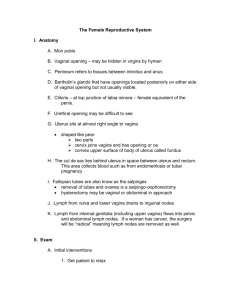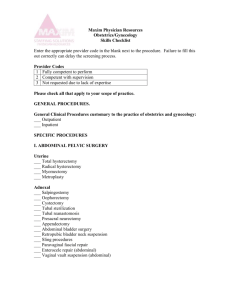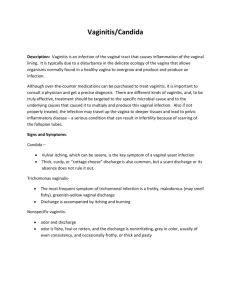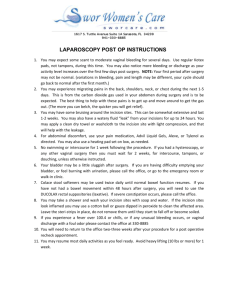procedures of aesthetic vaginal surgery
advertisement
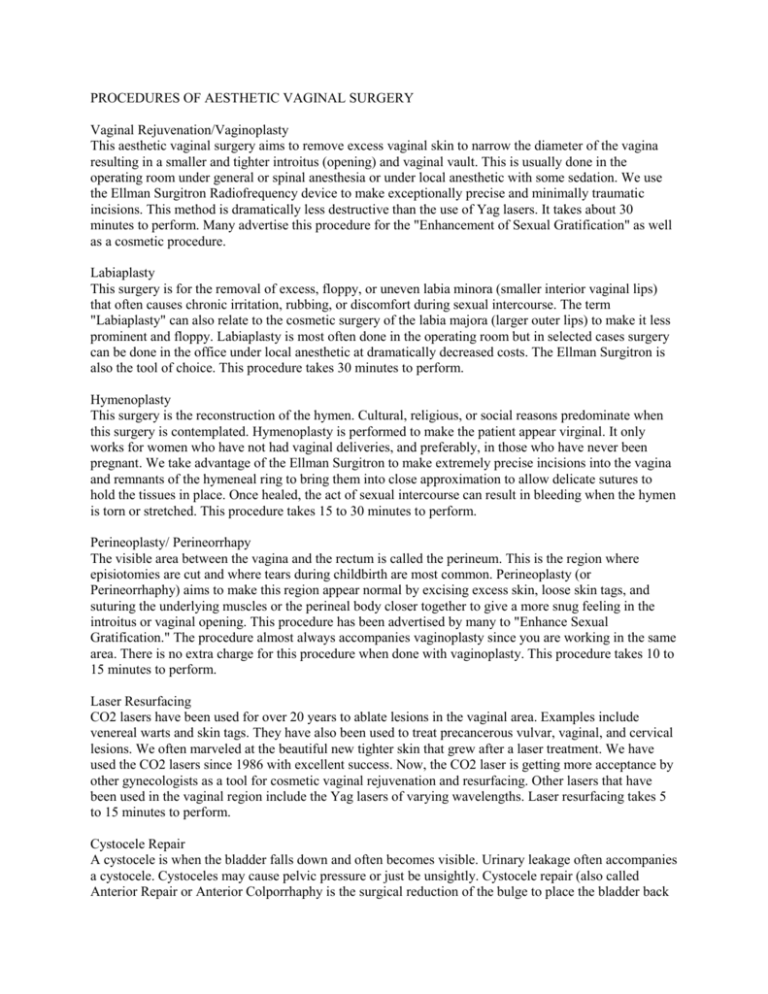
PROCEDURES OF AESTHETIC VAGINAL SURGERY Vaginal Rejuvenation/Vaginoplasty This aesthetic vaginal surgery aims to remove excess vaginal skin to narrow the diameter of the vagina resulting in a smaller and tighter introitus (opening) and vaginal vault. This is usually done in the operating room under general or spinal anesthesia or under local anesthetic with some sedation. We use the Ellman Surgitron Radiofrequency device to make exceptionally precise and minimally traumatic incisions. This method is dramatically less destructive than the use of Yag lasers. It takes about 30 minutes to perform. Many advertise this procedure for the "Enhancement of Sexual Gratification" as well as a cosmetic procedure. Labiaplasty This surgery is for the removal of excess, floppy, or uneven labia minora (smaller interior vaginal lips) that often causes chronic irritation, rubbing, or discomfort during sexual intercourse. The term "Labiaplasty" can also relate to the cosmetic surgery of the labia majora (larger outer lips) to make it less prominent and floppy. Labiaplasty is most often done in the operating room but in selected cases surgery can be done in the office under local anesthetic at dramatically decreased costs. The Ellman Surgitron is also the tool of choice. This procedure takes 30 minutes to perform. Hymenoplasty This surgery is the reconstruction of the hymen. Cultural, religious, or social reasons predominate when this surgery is contemplated. Hymenoplasty is performed to make the patient appear virginal. It only works for women who have not had vaginal deliveries, and preferably, in those who have never been pregnant. We take advantage of the Ellman Surgitron to make extremely precise incisions into the vagina and remnants of the hymeneal ring to bring them into close approximation to allow delicate sutures to hold the tissues in place. Once healed, the act of sexual intercourse can result in bleeding when the hymen is torn or stretched. This procedure takes 15 to 30 minutes to perform. Perineoplasty/ Perineorrhapy The visible area between the vagina and the rectum is called the perineum. This is the region where episiotomies are cut and where tears during childbirth are most common. Perineoplasty (or Perineorrhaphy) aims to make this region appear normal by excising excess skin, loose skin tags, and suturing the underlying muscles or the perineal body closer together to give a more snug feeling in the introitus or vaginal opening. This procedure has been advertised by many to "Enhance Sexual Gratification." The procedure almost always accompanies vaginoplasty since you are working in the same area. There is no extra charge for this procedure when done with vaginoplasty. This procedure takes 10 to 15 minutes to perform. Laser Resurfacing CO2 lasers have been used for over 20 years to ablate lesions in the vaginal area. Examples include venereal warts and skin tags. They have also been used to treat precancerous vulvar, vaginal, and cervical lesions. We often marveled at the beautiful new tighter skin that grew after a laser treatment. We have used the CO2 lasers since 1986 with excellent success. Now, the CO2 laser is getting more acceptance by other gynecologists as a tool for cosmetic vaginal rejuvenation and resurfacing. Other lasers that have been used in the vaginal region include the Yag lasers of varying wavelengths. Laser resurfacing takes 5 to 15 minutes to perform. Cystocele Repair A cystocele is when the bladder falls down and often becomes visible. Urinary leakage often accompanies a cystocele. Cystoceles may cause pelvic pressure or just be unsightly. Cystocele repair (also called Anterior Repair or Anterior Colporrhaphy is the surgical reduction of the bulge to place the bladder back into its normal anatomic location. The traditional repair of plicating or overlapping tissues with suture unfortunately has a very high failure rate ranging from 25 to 60 percent. It is certainly one of the most challenging surgeries gynecologists and urogynecologists perform. More modern surgery treats cystoceles as a hernia of the bladder into the vagina, hence, the use of mesh or donor tissues as a patch or graft has been gaining steady acceptance. We have some of the most extensive experience in this type of surgery in the United States with success rates of about 90% in our hands. Urethrocele Repair The urethra is the tube that drains the bladder. The urethra is where you see urine coming out. This structure may fall down just like the bladder does. This often results in leakage of urine when one coughs, laughs, jumps, or bends down. Repair of this organ often means you must place a mesh below it and support it to stop the leakage of urine. Many women have urethroceles with absolutely no symptoms. No surgery is needed in these asymptomatic patients. Rectocele Repair When the bulge into the vagina comes from the rectum it is called a rectocele. As with other forms of pelvic organ prolapse (cystoceles, enteroceles, vaginal prolapse) childbirth, chronic cough, chronic constipation, and obesity are predisposing factors. Symptoms are similar to cystoceles such as pelvic pressure, an unsightly bulge in the vagina, and constipation. Furthermore, the need of reaching into the vagina to push stool out is not uncommon. Surgical repair consists of using sutures to bunch up the bulging tissues together. More modern repair consists of the use of mesh or donor tissues. This newer method gives success rates of over 95% in our hands. Enterocele Repair A bulge into the vagina can also be caused by small bowel pushing the vaginal tissues. This is called an enterocele. It can occur at the same time as a cystocele and a rectocele. In fact, we often cannot tell what is causing the bulge in the vagina whether it is bladder, rectum, or bowel, or all! Modern repair uses mesh or donor tissue with excellent success found. This repair is technically quite challenging and few are trained in the modern repair of this problem. Vaginal Vault Suspension A vagina that looses its support may come down and out into the open air. The degree of vaginal prolapse may vary from just having the top fall down a few centimeters to ones that completely go inside out. If a woman still has her uterus then this is called a uterovaginal prolapse. If only the uterus falls out and the top of the vagina is still well suspended then it is called a uterine prolapse. Vaginal vault suspension can be done in many ways. Some physicians prefer an abdominal approach to attach the top of the fallen vagina to the sacrum. Some highly skilled surgeons do this laparoscopicaly. The procedure is called a sacralcolpopexy. More often a vaginal approach is performed. The top of the vagina can be sutured to the uterosacral ligaments or to the sacrospinous ligaments. Either approach works well with different complications to consider. A newer procedure called the Posterior IVS (Intravaginal Slingplasty) has been developed in Australia and New Zealand, popularized in Europe, and now approved in the United States. This vaginal approach uses a polypropylene mesh that is attached to the top of the vagina and suspended "tension-free" via two small incisions near the anus and one incision in the vagina. You can view this procedure in my Video Library. The success rates of all methods are approximately the same at 80 - 90%. Incontinence Sling The newest and safest trend to deal with incontinence involves the use of polypropylene, an inert nylontype material, that is placed right under the mid urethra to act as a backboard when one sneezes or coughs to then occlude or block the urethral opening and either decrease of stop the leakage of urine. These procedures are all called "Tension-Free" because the slings are not sutured into muscle, fascia, or bone and are just left alone for ones own fibroblast to ingrow and hold the mesh. You may hear the term TVT or TOT. They refer to the route the slings are placed. TVT, or tension-free vaginal tape can be placed through an incision right above your pubic bone. TOT, or transobturator tape, is placed through incisions on the crease of your inner thighs. These incisions are just about invisible. Both procedures are outpatient surgeries of about 15 to 30 minutes. The success rates vary from 80 to 95 percent.


